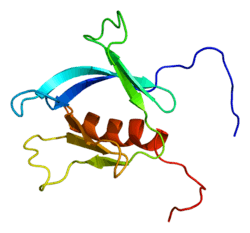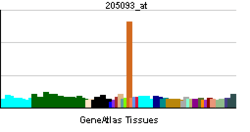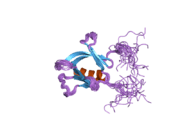PLEKHA6
Pleckstrin homology domain-containing family A member 6 is a protein that in humans is encoded by the PLEKHA6 gene.[2][3]
References
Further reading
- Clark TA, Schweitzer AC, Chen TX, et al. (2007). "Discovery of tissue-specific exons using comprehensive human exon microarrays.". Genome Biol. 8 (4): R64. doi:10.1186/gb-2007-8-4-r64. PMC 1896007
 . PMID 17456239.
. PMID 17456239.
- Beausoleil SA, Villén J, Gerber SA, et al. (2006). "A probability-based approach for high-throughput protein phosphorylation analysis and site localization.". Nat. Biotechnol. 24 (10): 1285–92. doi:10.1038/nbt1240. PMID 16964243.
- Zhang Y, Wolf-Yadlin A, Ross PL, et al. (2005). "Time-resolved mass spectrometry of tyrosine phosphorylation sites in the epidermal growth factor receptor signaling network reveals dynamic modules.". Mol. Cell Proteomics. 4 (9): 1240–50. doi:10.1074/mcp.M500089-MCP200. PMID 15951569.
- Ota T, Suzuki Y, Nishikawa T, et al. (2004). "Complete sequencing and characterization of 21,243 full-length human cDNAs.". Nat. Genet. 36 (1): 40–5. doi:10.1038/ng1285. PMID 14702039.
- Strausberg RL, Feingold EA, Grouse LH, et al. (2003). "Generation and initial analysis of more than 15,000 full-length human and mouse cDNA sequences.". Proc. Natl. Acad. Sci. U.S.A. 99 (26): 16899–903. doi:10.1073/pnas.242603899. PMC 139241
 . PMID 12477932.
. PMID 12477932.
- Dias Neto E, Correa RG, Verjovski-Almeida S, et al. (2000). "Shotgun sequencing of the human transcriptome with ORF expressed sequence tags.". Proc. Natl. Acad. Sci. U.S.A. 97 (7): 3491–6. doi:10.1073/pnas.97.7.3491. PMC 16267
 . PMID 10737800.
. PMID 10737800.
- Nagase T, Ishikawa K, Suyama M, et al. (1999). "Prediction of the coding sequences of unidentified human genes. XIII. The complete sequences of 100 new cDNA clones from brain which code for large proteins in vitro.". DNA Res. 6 (1): 63–70. doi:10.1093/dnares/6.1.63. PMID 10231032.
PDB gallery |
|---|
|
| 2d9y: Solution structure of the PH domain of PEPP-3 from human |
|
|


 . PMID 11001876.
. PMID 11001876. . PMID 17456239.
. PMID 17456239. . PMID 12477932.
. PMID 12477932. . PMID 10737800.
. PMID 10737800.